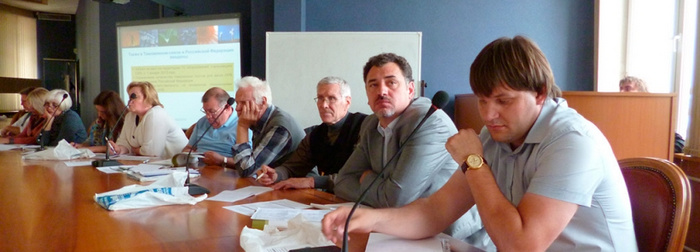17.06.2014 - 18.06.2014 - UNIDO presented draft certification course for refrigeration installation, repair and maintenance technicians
On June 17–18, 2014, GAOU UTs Professional placed two-day UNIDO’s workshop “Establishment of the certification and accreditation system for technicians engaged in installation, maintenance and repair of refrigerating, air-conditioning equipment and heat pumps.”

The list of participants included: I. G. Kukushkin, vice-president of the Russian Chemist Union, V. B. Sapozhnikov, doctor of engineering, heads, specialists and instructors of GAOU UTs Professional, representatives of administrations of education and educational institutions of Moscow and Russian regions, heads and specialists of OAO Rot Front, OAO Wimm-Bill-Dann, OOO Unilever Rus, etc.

When opening the workshop, I. V. Tsirin, director of Professional training center, spoke on importance and function of certification in the context of the Russian qualification system, and informed those present on lines of cooperation between GAOU UTs Professional and UNIDO Centre.
The presentation covered 4 levels of professional development programs for professionals engaged in current maintenance and servicing of refrigerating installations as well as management, training and knowledge assessment of staff.
The workshop participants were offered a tour to the teaching block of GAOU UTs Professional located at bld. 1 of Ryazansky prospekt 7. They were shown modern refrigerating, heat pump, and air-conditioning equipment granted by UNIDO to train technicians, and a double-chamber air cryosauna used to rehabilitate individuals with disabilities in parallel with training.


After the workshop, the participants including employees and instructors of GAOU UTs Professional, obtained certificates.
Manuals prepared by UNIDO

Study guide for refrigerating, heat pump, and air-conditioning equipment technicians
The study guide presents operating principles of vapor-compression refrigerating machines and examines various types of refrigerating equipment.
Besides, it covers major components of refrigerating systems—such as compressors, heat exchangers, expansion valves, automation and control devices—and details design of commercial and domestic air-conditioning systems—such as split-systems, multi split-systems, chiller-fancoil systems, etc.—and refrigerating equipment.
The guide also expounds installation, adjustment, maintenance and repair procedures as applied for refrigerating systems.
A separate unit is dedicated to refrigerants and their impact on the Earth’s atmosphere.
Refrigerants are classified as synthetic (CFC, HCFC, and HFC single-component and mixtures) and natural (hydrocarbons, ammonia, carbon dioxide). The guide also covers oils used with those refrigerants.
The ozone layer depletion caused by emissions of CFC refrigerants and impact of F-gases on the global warming are examined in detail. International treaties that restrict polluting emissions into the atmosphere are also included in the guide.

Legislative control of refrigerants in the Russian Federation and the territory of the Customs Union
Study guide “Legislative control of refrigerants in the Russian Federation and the territory of the Customs Union” presents measures being taken and planned as for refrigerant market regulation in the Russian Federation and Customs Union.
The study guide describes the following refrigerant classes: ozone-depleting and transitional (CFC and HCFC), fluoro-containing (HFC), natural (hydrocarbons, ammonia, carbon dioxide). For every class, it presents basic provisions of regulatory documents that control their use in the Russian Federation or Customs Union.

Retraining program for installation technicians as regards compression ammonia refrigeration plant with qualification of class 5 installer
The document describes a retraining program aimed at creating professional capacities necessary for professional installation, pre-commissioning, testing, and commissioning activities as regards primary and supporting equipment of vapor-compression ammonia refrigerating units.
To master the program, an applicant needs to: have a state or standard diploma of secondary vocational or higher non-core technical education, and, if possible, at least 1-year employment history of installation and/or operation of refrigerating and/or air-conditioning equipment. The program also contains the list of skills and knowledge to be obtained during the training.
The curriculum and contents provide for studying: basics of thermodynamics, industrial heating engineering, industrial hydraulics, refrigeration engineering, building technology, engineering graphics, constructional drawing, materials technology, general electrical engineering, electric drive, industrial electronics, electric power supply, metrology and compatibility, standardization and certification, HSE, VCRM operation automation and control systems, assembly of components, blocks, and units of basic and auxiliary equipment of vapor compression ammonia refrigerating machines, electro-gas welding equipment, techniques, and technology.
The course takes 864 hours, of them 264 are skill building sessions.

Safety standard for R717 (ammonia) refrigerating systems
The standard presents rules, requirements and recommendations for safe installation and operation of ammonia refrigerating units (ARU), lists risk factors professionals working with ARU may encounter, and describes ARU components.
It also specifies all the aspects of designing ARU, including selection of component materials, location and arrangement of pipes, installation of safety devices and instruments.
The guide describes testing and commissioning procedures as for ammonia systems, their scheduled maintenance and repair, and dismantling with refrigerant recovery.
Requirements for ARU machine rooms, their equipment and staff outfit are also specified.
Annexes contain the oil drain procedure and ammonia system assessment form.

Retraining program on specifics of installation and service works for hydrocarbon refrigerants
Guide “Specifics of installation and service works for hydrocarbon refrigerants” covers problems of using hydrocarbons (HC) in refrigerating and air-conditioning equipment. Specifically, it describes the history of using HC, their advantages as compared to other refrigerants (pure and mixed chlorofluorocarbons, hydrofluorocarbons, and hydrofluorocarbons), and risks related to such HC properties as flammability, volatility (low evaporation temperature), and unfitness for respiration.
The guide presents tools for safe handling of HC refrigerants, and information and recommended practices as regards storage, use, and disposal of HC refrigerants.
A separate unit is dedicated to transition from ODS to HC refrigerants. Term “transition” means use of a flammable refrigerant in a system that earlier was operated with a non-flammable refrigerant, i.e. use of R290 (propane) or R1290 (propylene) instead of R22 or R407C.
It is important to distinguish transition from such terms as re-fill, drop-in and retrofit. Due to HC lower price as compared to other refrigerants and absence of any alternatives, hydrocarbons may replace ozone-depleting and/or contributing global warming refrigerants in domestic air-conditioners with the aim to improve the system energy efficiency, and cut environmental impact.


